Griffiths D. Head First Statistics
Подождите немного. Документ загружается.

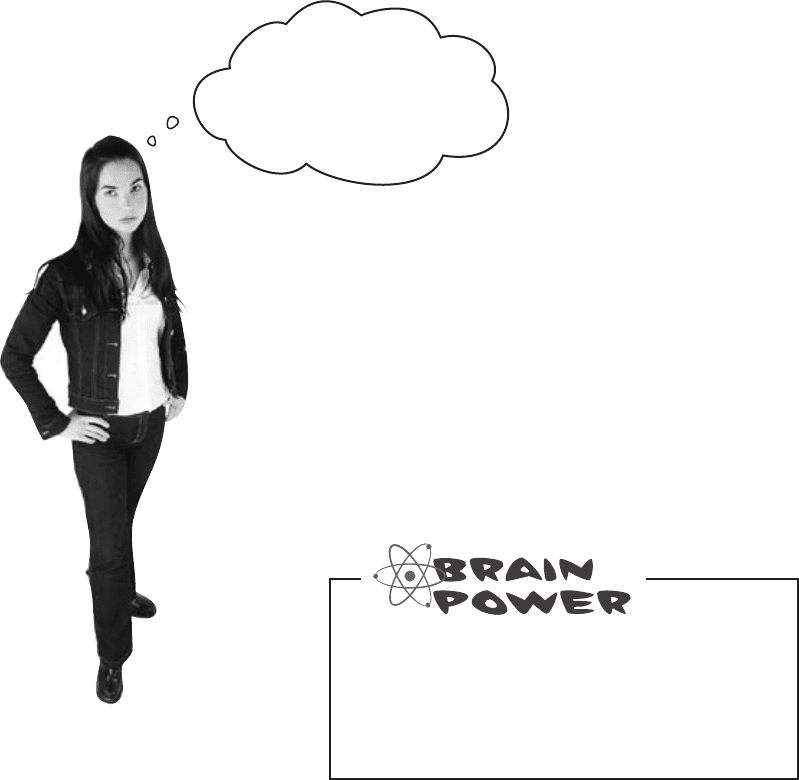
you are here 4 131
calculating probabilities
Place your bets now!
Have you cut out your roulette board? The game is
just beginning. Where do you think the ball will land?
Choose a number on your roulette board, and then
we’ll place a bet.
Right, before placing any bets, it makes
sense to see how likely it is that you’ll win.
Maybe some bets are more likely than others. It sounds
like we need to look at some probabilities...
What things do you need to think about
before placing any roulette bets? Given
the choice, what sort of bet would you
make? Why?
Hold it right there!
You want me to just make
random guesses? I stand
no chance of winning if I
just do that.
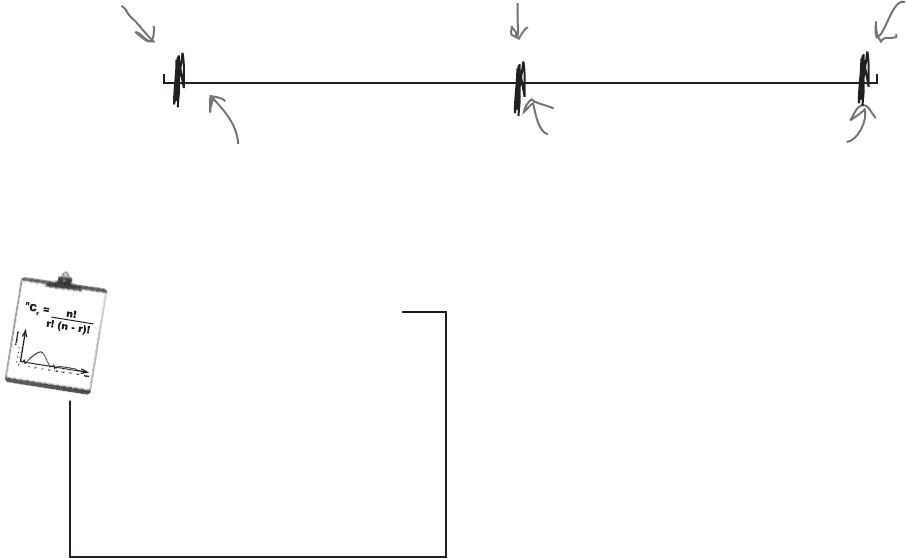
132 Chapter 4
Impossible
Equal chance of
happening or not
Certain
What are the chances?
Have you ever been in a situation where you’ve wondered “Now,
what were the chances of that happening?” Perhaps a friend has
phoned you at the exact moment you’ve been thinking about them,
or maybe you’ve won some sort of raffle or lottery.
Probability is a way of measuring the chance of something
happening. You can use it to indicate how likely an occurrence is
(the probability that you’ll go to sleep some time this week), or how
unlikely (the probability that a coyote will try to hit you with an
anvil while you’re walking through the desert). In stats-speak, an
event is any occurrence that has a probability attached to it—in
other words, an event is any outcome where you can say how likely
it is to occur.
Probability is measured on a scale of 0 to 1. If an event is
impossible, it has a probability of 0. If it’s an absolute certainty,
then the probability is 1. A lot of the time, you’ll be dealing with
probabilities somewhere in between.
Here are some examples on a probability scale.
A freak coyote anvil
attack is quite unlikely;
let’s put it here.
Falling asleep at some
point during a 168-
hour period is almost
certain.
Throwing a coin and
it landing heads up
happens in about half
of all tosses.
Can you see how probability
relates to roulette?
If you know how likely the ball is to land on a
particular number or color, you have some way
of judging whether or not you should place a
particular bet. It’s useful knowledge if you want
to win at roulette.
0
0.5
1
finding probability
Event
An outcome or occurrence that
has a probability assigned to it
Vital StatisticsVital Statistics

you are here 4 133
calculating probabilities
Let’s try working out a probability for roulette, the probability of
the ball landing on 7. We’ll guide you every step of the way.
1. Look at your roulette board. How many pockets are there for the ball to land in?
2. How many pockets are there for the number 7?
3. To work out the probability of getting a 7, take your answer to question 2 and divide it by your
answer to question 1. What do you get?
4. Mark the probability on the scale below. How would you describe how likely it is that you’ll get a 7?
0
0.5
1
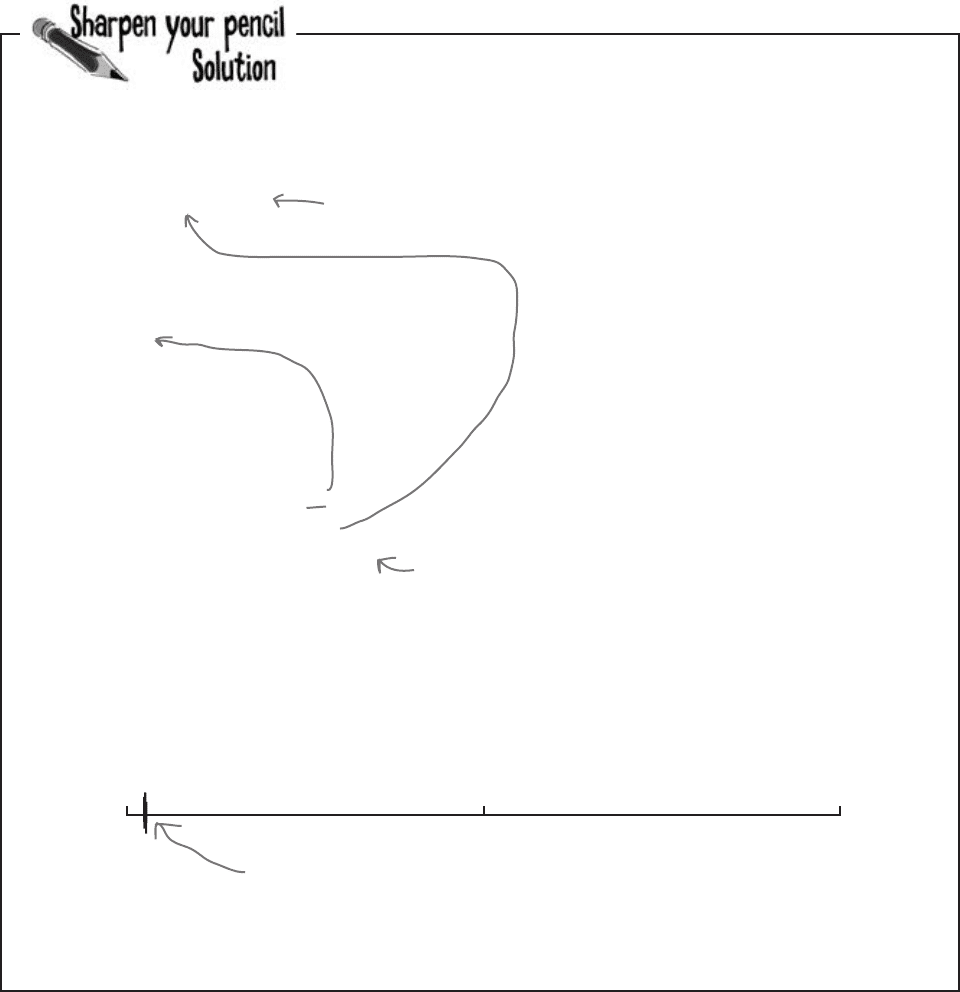
134 Chapter 4
You had to work out a probability for roulette, the probability of
the ball landing on 7. Here’s how you calculate the solution, step
by step.
1. Look at your roulette board. How many pockets are there for the ball to land in?
2. How many pockets are there for the number 7?
3. To work out the probability of getting a 7, take your answer to question 2 and divide it by your
answer to question 1. What do you get?
4. Mark the probability on the scale below? How would you describe how likely it is that you’ll get a 7?
There are 38 pockets.
Just 1
Probability of getting 7 = 1
38
= 0.026
The probability of getting a 7 is 0.026, so it
falls around here. It’s not impossible, but not
very likely.
Don’t forget that the ball can land in
0 or 00 as well as the 36 numbers.
0
0.5
1
sharpen solution
Our answer to 3 decimal places
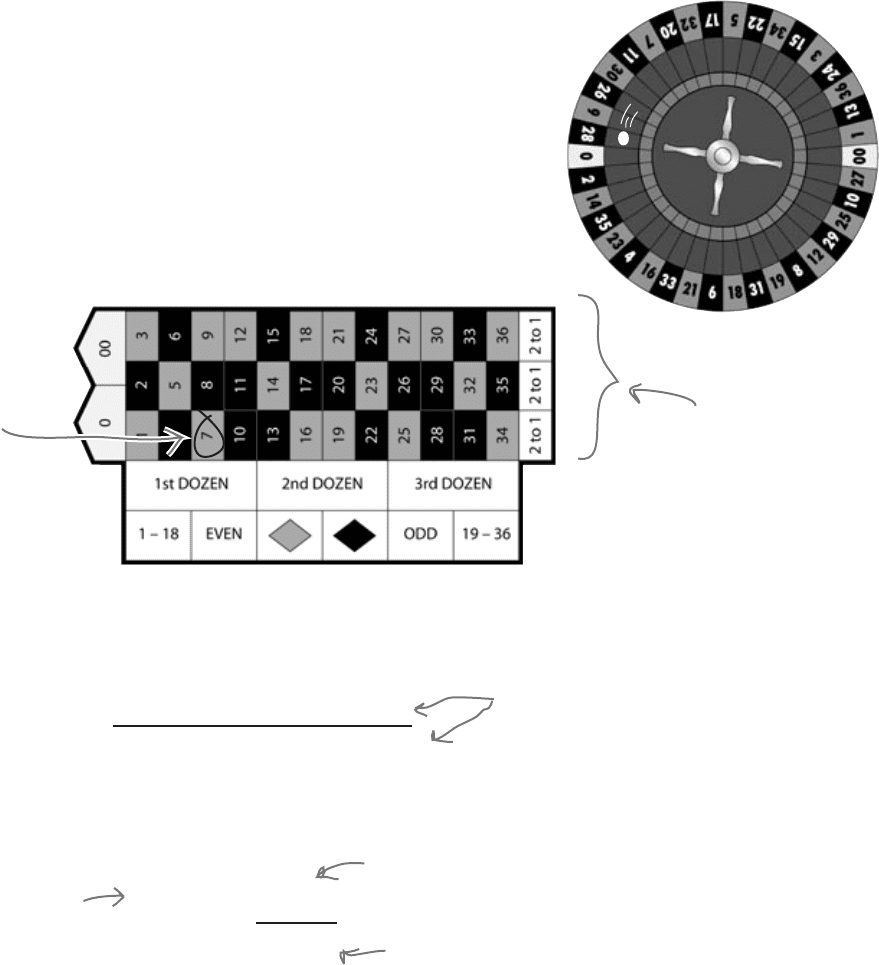
you are here 4 135
calculating probabilities
Find roulette probabilities
Let’s take a closer look at how we calculated that probability.
Here are all the possible outcomes from spinning the roulette
wheel. The thing we’re really interested in is winning the
bet—that is, the ball landing on a 7.
There’s just one event
we’re really interested
in: the probability of
the ball landing on a 7.
These are all possible
outcomes, as the ball
could land in any of
these pockets.
To find the probability of winning, we take the number of
ways of winning the bet and divide by the number of possible
outcomes like this:
Probability = number of ways of winning
number of possible outcomes
We can write this in a more general way, too. For the
probability of any event A:
There’s one way of getting a
7, and there are 38 pockets.
P(A) = n(A)
n(S)
Number of ways of
getting an event A
The number of
possible outcomes
S is known as the possibility space, or sample space. It’s
a shorthand way of referring to all of the possible outcomes.
Possible events are all subsets of S.
Probability of event
A occurring
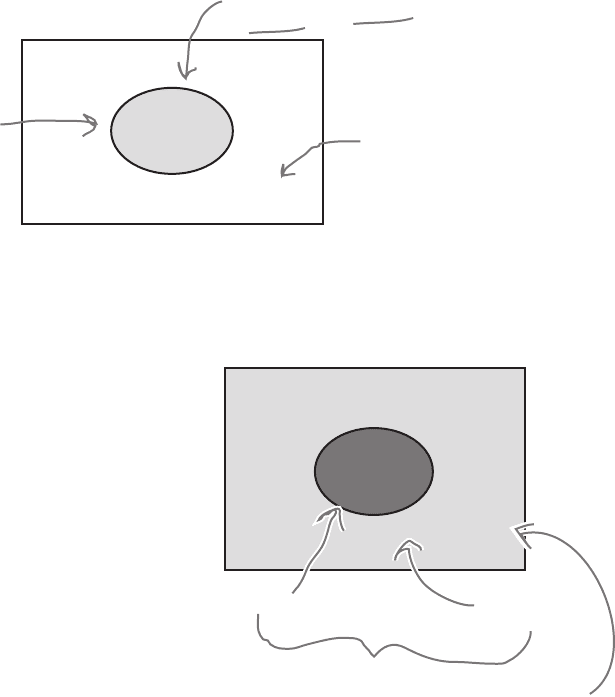
136 Chapter 4
S
A
S
A
A
I
Probabilities can quickly get complicated, so it’s often
very useful to have some way of visualizing them.
One way of doing so is to draw a box representing
the possibility space S, and then draw circles for each
relevant event. This sort of diagram is known as a Venn
diagram. Here’s a Venn diagram for our roulette
problem, where A is the event of getting a 7.
1
37
Here’s the event for
getting a 7. It has a
1 in it, as there’s one
way of getting a 7.
There’s a 37 here, as
there are 37 other
possible events: the
pockets that aren’t
part of event A.
Very often, the numbers themselves aren’t shown on the
Venn diagram. Instead of numbers, you have the option
of using the actual probabilities of each event in the
diagram. It all depends on what kind of information you
need to help you solve the problem.
Complementary events
There’s a shorthand way of indicating the event
that A does not occur—A
I
. A
I
is known as the
complementary event of A.
There’s a clever way of calculating P(A
I
). A
I
covers every
possibility that’s not in event A, so between them, A and
A
I
must cover every eventuality. If something’s in A, it
can’t be in A
I
, and if something’s not in A, it must be in
A
I
. This means that if you add P(A) and P(A
I
) together,
you get 1. In other words, there’s a 100% chance that
something will be in either A or A
I
. This gives us
P(A) + P(A
I
) = 1
or
P(A
I
) = 1 - P(A)
In A
Not in A
Probability 1
probabilities and venn diagrams
You can visualize probabilities with a Venn diagram
The actual size of the circle isn’t important
and doesn’t indicate the relative probability
of an event occurring. The key thing is what
it includes and excludes.
In this diagram, A’ is used
instead of 37 to indicate
all the possible events
that aren’t in A

you are here 4 137
calculating probabilities
P(9)
P(Black)
P(Green)
P(38)
BE the croupier
Your job is to imagine you’re
the croupier and work out the
probabilities of various events.
For each event below, write down
the probability of a successful
outcome.

138 Chapter 4
P(9)
P(Black)
P(Green)
P(38)
BE the croupier Solution
Your job was to imagine you’re
the croupier and work out the
probabilities of various events.
For each event you should have
written down the probability of
a successful outcome.
2 of the pockets are green, and there are
38 pockets total, so:
Probability = 2
38
= 0.053 (to 3 decima
l places)
The probability of getting a 9 is exactly the same
as getting a 7, as there’s an equal chance of the
ball falling into each pocket.
Probability = 1
38
= 0.026 (to 3 decima
l places)
18 of the pockets are black, and there are 38
pockets, so:
Probability = 18
38
= 0.474 (to 3 decima
l places)
This event is actually impossible—there
is no pocket labeled 38. Therefore, the
probability is 0.
The most likely event out of all these is
that the ball will land in a black pocket.
be the roulette wheel solution
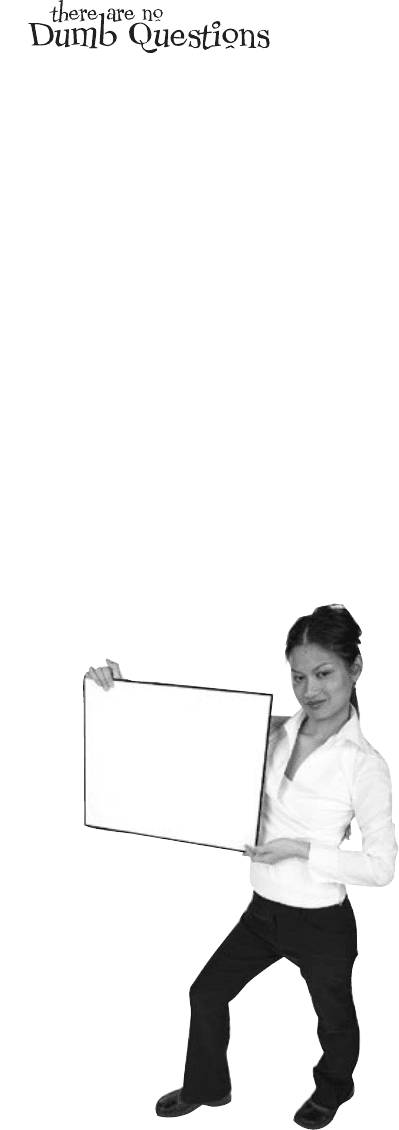
you are here 4 139
calculating probabilities
Bet:
Black
Let’s see what
happens.
Q:
Why do I need to know about
probability? I thought I was learning
about statistics.
A: There’s quite a close relationship
between probability and statistics. A lot
of statistics has its origins in probability
theory, so knowing probability will take your
statistics skills to the next level. Probability
theory can help you make predictions about
your data and see patterns. It can help you
make sense of apparent randomness. You’ll
see more about this later.
Q:
Are probabilities written as
fractions, decimals, or percentages?
A: They can be written as any of these.
As long as the probability is expressed in
some form as a value between 0 and 1, it
doesn’t really matter.
Q:
I’ve seen Venn diagrams before in
set theory. Is there a connection?
A: There certainly is. In set theory, the
possibility space is equivalent to the set of
all possible outcomes, and a possible event
forms a subset of this. You don’t have to
already know any set theory to use Venn
diagrams to calculate probability, though, as
we’ll cover everything you need to know in
this chapter.
Q:
Do I always have to draw a Venn
diagram? I noticed you didn’t in that last
exercise.
A: No, you don’t have to. But sometimes
they can be a useful tool for visualizing
what’s going on with probabilities. You’ll see
more situations where this helps you later on.
Q:
Can anything be in both events A
and A
I
?
A: No. A
I
means everything that isn’t in
A. If an element is in A, then it can’t possibly
be in A
I
. Similarly, if an element is in A
I
, then
it can’t be in A. The two events are mutually
exclusive, so no elements are shared
between them.
It’s time to play!
A game of roulette is just about to begin.
Look at the events on the previous page.
We’ll place a bet on the one that’s most
likely to occur—that the ball will land in a
black pocket.
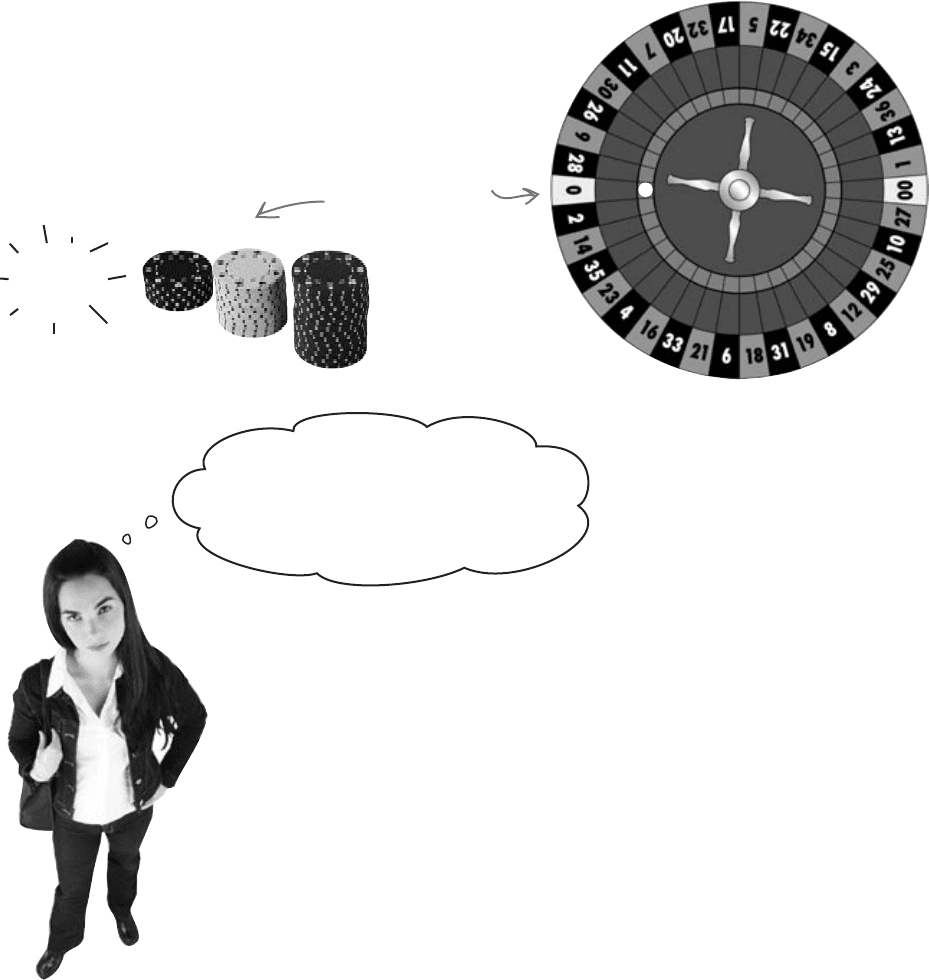
140 Chapter 4
And the winning number is...
Oh dear! Even though our most likely probability was
that the ball would land in a black pocket, it actually
landed in the green 0 pocket. You lose some of your
chips.
There must be a fix! The probability
of getting a black is far higher than
getting a green or 0. What went wrong? I
want to win!
Probabilities are only indications of how likely
events are; they’re not guarantees.
The important thing to remember is that a probability indicates
a long-term trend only. If you were to play roulette thousands
of times, you would expect the ball to land in a black pocket
in 18/38 spins, approximately 47% of the time, and a green
pocket in 2/38 spins, or 5% of the time. Even though you’d
expect the ball to land in a green pocket relatively infrequently,
that doesn’t mean it can’t happen.
No matter how
unlikely an event is, if
it’s not impossible, it
can still happen.
The ball landed in
the 0 pocket, so
you lost some chips.
probabilities aren’t guarantees
